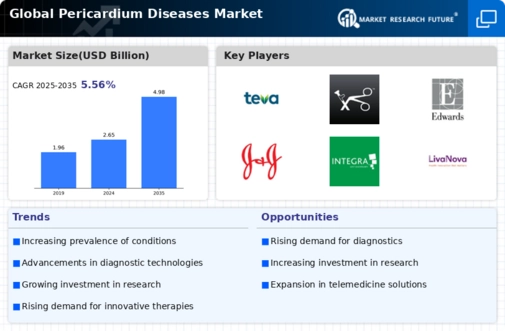Rising Geriatric Population
The aging population globally is a significant factor influencing the Global Pericardium Diseases Market Industry. As individuals age, the risk of developing cardiovascular diseases, including pericardial conditions, increases. The World Health Organization projects that by 2030, the number of people aged 60 years and older will reach 1.4 billion, further elevating the demand for healthcare services related to pericardium diseases. This demographic shift necessitates the development of specialized treatments and management strategies tailored to older adults. Consequently, the market is poised for substantial growth, driven by the need to address the unique healthcare challenges faced by this population.
Market Trends and Projections
Growing Awareness and Education
Increased awareness and education regarding pericardial diseases are pivotal drivers of the Global Pericardium Diseases Market Industry. Healthcare campaigns and educational programs aimed at both healthcare professionals and the general public are fostering a better understanding of these conditions. This heightened awareness leads to earlier diagnosis and treatment, which is essential for improving patient outcomes. As more individuals recognize symptoms and seek medical attention, the market is likely to expand. The anticipated growth rate of 5.91% CAGR from 2025 to 2035 suggests that ongoing educational initiatives will continue to play a crucial role in shaping the market landscape.
Advancements in Diagnostic Technologies
Technological advancements in diagnostic tools are significantly impacting the Global Pericardium Diseases Market Industry. Innovations such as echocardiography, cardiac MRI, and CT scans enhance the accuracy of diagnosing pericardial diseases. These technologies enable early detection and better management of conditions, which is crucial for improving patient outcomes. As healthcare providers adopt these advanced diagnostic methods, the demand for related services and products is expected to rise. This trend is likely to contribute to the market's growth, with projections indicating an increase to 4.98 USD Billion by 2035, as more patients receive timely and accurate diagnoses.
Rising Incidence of Pericardium Diseases
The Global Pericardium Diseases Market Industry is experiencing growth due to the increasing incidence of pericardial diseases, which include pericarditis and pericardial effusion. Factors such as urbanization, lifestyle changes, and an aging population contribute to this rise. For instance, the prevalence of cardiovascular diseases has been on the rise globally, leading to a higher incidence of pericardial conditions. In 2024, the market is projected to reach 2.65 USD Billion, reflecting the urgent need for effective diagnostic and therapeutic solutions. As awareness increases, healthcare systems are likely to allocate more resources to manage these conditions, further driving market growth.
Increasing Investment in Healthcare Infrastructure
Investment in healthcare infrastructure is a crucial driver for the Global Pericardium Diseases Market Industry. Governments and private entities are increasingly allocating funds to enhance healthcare facilities, particularly in developing regions. This investment is aimed at improving access to diagnostic and treatment options for pericardial diseases. Enhanced infrastructure facilitates the implementation of advanced technologies and training for healthcare professionals, which is essential for effective disease management. As healthcare systems evolve, the market is expected to benefit from improved service delivery, ultimately contributing to its growth trajectory.

















